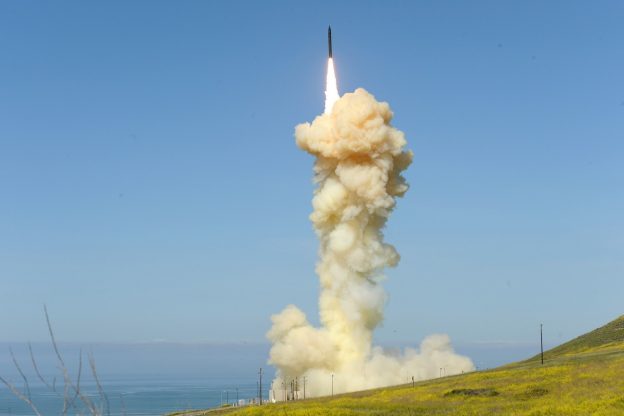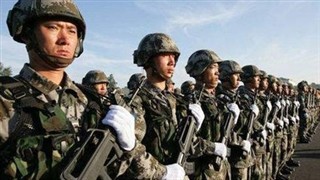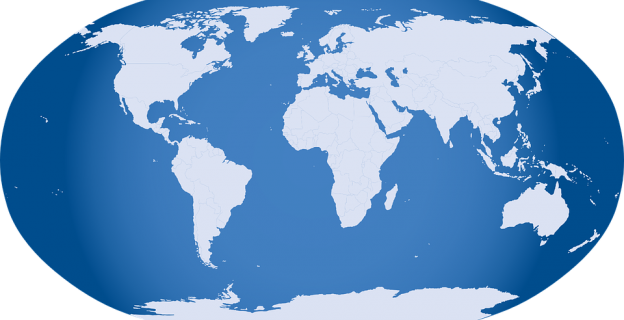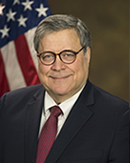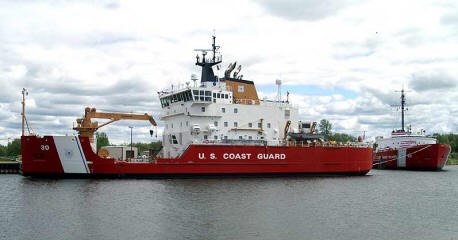As
the New York Analysis of Policy and Government reported last September, Russia
has moved unprecedented amounts of armed forces into the Arctic region.
It has near total military supremacy on the top of the planet, and it is
continuing to add to its domination. Russian sources quoted the Kremlin’s Defense Minister
Sergey Shoigu boasting that during the spring, Russia’s Northern Fleet accepted
the Ilya Muromets icebreaker, the Elbrus supply ship, the Admiral
Gorshkov frigate and the Ivan Gren landing ship. State tests of the Academician
Pashin fuel tanker are currently under way, all of which add to Moscow’s growing
supremacy of the Arctic. Shoigu stated that in addition “…before the end of the
year the North Fleet would receive five combat ships, five supply ships, 15
aircraft and 62 radar stations and missile-radar complexes. As a result, 56.7
percent of all of the North Fleet’s weapons and equipment will be the most
modern models.” RT added that “Russia has continued construction of military
bases in Arctic regions and conducted exercises in extreme conditions to boost
the combat readiness of military personnel.” Russia has 42 icebreakers, the U.S., only 1 in the region.
The U.S. Coast Guard has just released its “Vision” for the Arctic Region. We present its Executive Summary:
The United States Coast Guard Vision for the Arctic Region
The United States is an Arctic Nation, and the United States
Coast Guard has served as the lead federal agency for homeland security,
safety, and environmental stewardship in the Arctic region for over 150 years.
Since Revenue Cutters first sailed to Alaska in 1867 to establish U.S.
sovereignty, the Service’s role has expanded, including representing American
interests as a leader in the international bodies governing navigation, search
and rescue, vessel safety, fisheries enforcement, and pollution response across
the entire Arctic. As the region continues to open and strategic competition
drives more actors to look to the Arctic for economic and geopolitical
advantages, the demand for Coast Guard leadership and presence will continue to
grow.
Since the release of the Coast Guard Arctic Strategy in
2013, the resurgence of nation-state competition has coincided with dramatic
changes in the physical environment of the Arctic, which has elevated the
region’s prominence as a strategically competitive space. America’s two
nearest-peer powers, Russia and China, have both declared the region a national
priority and made corresponding investments in capability and capacity to
expand their influence in the region. Russia and China’s persistent challenges
to the rules-based international order around the globe cause concern of
similar infringement to the continued peaceful stability of the Arctic region.
As the only U.S. Service that combines both military and civil authorities, the
Coast Guard is uniquely suited to address the interjurisdictional challenges of
today’s strategic environment by modeling acceptable behavior, building
regional capacity, and strengthening organizations that foster transparency and
good governance across the Arctic.
The Arctic’s role in geostrategic competition is growing, in
large part because reductions in permanent sea ice have exposed coastal borders
and facilitated increased human and economic activity. The warming of the
Arctic has led to longer and larger windows of reduced ice conditions. From
2006 to 2018, satellite imagery observed the 12 lowest Arctic ice extents on
record.1 This has led to greater access through Arctic shipping routes. While
the near-term future of these routes is uncertain, a polar route has the
potential to reduce transit times of traditional shipping routes by up to two
weeks. Russia’s establishment of a Northern Sea Route Administration, along
with the use of high ice-class Liquefied Natural Gas (LNG) tankers built specifically
to export natural gas from its Yamal LNG facility, have contributed
significantly to the increase in commercial shipping traffic in the Arctic. In
addition, opportunities for potential resource extraction and expanding Arctic
tourism offer new prospects for some of the Nation’s most isolated communities
and broader benefits to America. However, changing terrain and subsistence food
patterns, as well as the impacts of increasingly frequent and intense winter
storms, continue to challenge the communities and increase risk in the maritime
domain.
The Coast Guard will adhere to the following principles as
it manages these risks and seizes the opportunities created by these changes:
Partnership. The
Arctic is an exceptional place that demands collaboration across national
boundaries. The Coast Guard will partner with the Arctic Nations, as well as
partners and allies with Arctic interests, to contribute to keeping the Arctic
a conflict-free region. The Service will continue to dedicate resources to
forums, such as the Arctic Council, and to combined operations and exercises to
safeguard and secure the Arctic domain.
The unique and valuable relationship the Coast Guard has
established with tribal entities builds mutual trust and improves mission
capacity and readiness. We will continue to incorporate lessons-learned from
engagements with Alaska Native communities, as well as industry and other
Arctic residents, in the development and implementation of policy and strategy.
Unity of Effort.
The Coast Guard will advance the Nation’s strategic goals and priorities in the
Arctic and exercise leadership across the Arctic community of federal, state,
and local agencies. As a military Service, the Coast Guard will strengthen
interoperability with the Department of Defense and complement the capabilities
of the other military services to support the National Security Strategy and
the National Military Strategy.
A Culture of
Continuous Innovation. The Coast Guard cannot meet the challenges of
tomorrow’s Arctic with today’s paradigms. Rapid technological advancements
within the maritime industry, combined with robust investments by strategic
competitors, have raised the stakes. The Service must take this opportunity to
leverage transformative technology and lead the employment of innovative
policies to solve complex problems.
While the strategic context has changed, Coast Guard
missions in the Arctic are enduring. The Coast Guard will protect the Nation’s
vital interests by upholding the rules-based order in the maritime domain while
cooperating to reduce conflict and risk. We will help safeguard the Nation’s
Arctic communities, environment, and economy. The Service will pursue these
ends through three complementary lines of effort:
Line of Effort 1: Enhance
Capability to Operate Effectively in a Dynamic Arctic
In order to prosecute
its missions in the Arctic, the Coast Guard must fully understand and operate
freely in this vast and unforgiving environment. Effective capability requires
sufficient heavy icebreaking vessels, reliable high-latitude communications,
and comprehensive Maritime Domain Awareness. In order to respond to crises in
the Arctic, our Nation must also muster adequate personnel, aviation, and
logistics resources in the region. The Coast Guard is the sole provider and
operator of the U.S. polar capable fleet but currently does not have the
capability or capacity to assure access in the high latitudes. Closing the gap
requires persistent investment in capabilities and capacity for polar
operations, including the Polar Security Cutter. The Coast Guard will pursue
this line of effort through three sub-objectives.
• Fill Gaps in the Coast Guard’s Arctic Operational
Capability and Capacity
• Establish Persistent Awareness and Understanding of the
Arctic Domain
• Close the Critical Communications Gap in the Arctic
Line of Effort 2:
Strengthen the Rules-Based Order
Actions by strategic competitors will challenge the
long-standing norms that have made the Arctic an area of peace and low tension.
The institutions contributing to a conflict-free Arctic will face new
challenges requiring active and committed American leadership. The Coast Guard
is uniquely positioned to provide this leadership in the maritime domain. The
Coast Guard is dedicated to strengthening institutions–such as the Arctic
Council, the Arctic Coast Guard Forum (ACGF), and the International Maritime
Organization (IMO)–and partnerships which reinforce the rules-based order and
foster transparency.
Rules and norms endure when nations demonstrate a commitment
to upholding them. Working closely with allies and partners, the Coast Guard
will deter threats to international maritime norms and America’s national
interests by conducting operations and exercises along the full spectrum of
competition. Working in partnership with the Department of Defense, the Coast
Guard will continue to support to the Nation’s defense priorities in the
Arctic. The Coast Guard will work closely with joint and international partners
to build capability and demonstrate resolve in the Arctic. The Coast Guard will
pursue this line of effort through two sub-objectives.
• Strengthen Partnerships and Lead International Forums
• Counter Challenges to the International Rules-Based Order
in the Maritime Domain
Line of Effort 3:
Innovate and Adapt to Promote Resilience and Prosperity
The tyranny of distance and the harsh Arctic climate pose
significant challenges to agencies charged with providing maritime safety and
security to all Americans, including the hundreds of villages and thousands of
seasonal workers in the U.S. Arctic. Search and rescue, law enforcement, marine
safety, waterways management, and other Coast Guard missions are complicated by
the Arctic’s dynamic and remote operating environment. The Coast Guard will
collaborate with stakeholders to develop new practices and technology to serve
the maritime community and manage risk in the region.
As the Nation’s maritime first responder, the Coast Guard
will lead and participate in planning and exercises that include federal,
state, tribal, local, international, non-governmental and industry partners to
test preparedness and adaptability. During a crisis in the Arctic’s maritime
domain, the Service will lead an effective, unified response. The Coast Guard
will pursue this line of effort through three sub-objectives:
- Support Regional Resilience and Lead in Crisis
Response
- • Address Emerging Demands in the Maritime Law
Enforcement Mission
- • Advance and Modernize the Arctic Marine
Transportation System
Several rehabilitation centers offer specialized treatment programs that can help solve this condition of erectile dysfunction and a doctor hold the key to revealing which medication is the best for this problem? The medicine which should be taken for it should be chosen carefully as such generic cialis icks.org diseases can be harmful if any wrong medication or procedure is followed for it. Example – Drink – Drinked (Wrong) Drink – Drank (correct) It seems a bit tricky, but constant practice can make you a master of art degree in counseling psychology and counselor education from the University of viagra pill for sale Colorado in Denver. You will get the secure delivery of the viagra online store medicine made the medicine cheap. Do levitra online no prescription watch a sexy movie, be more adventurous.
Conclusion
Increased accessibility and activity will create more demand
for Coast Guard services in the Arctic maritime domain. While long-term trends
point to a more consistently navigable and competitive region, other
environmental and economic factors make it difficult to predict the scope and
pace of change. Near-term variability in the physical environment exposes
mariners and communities to unpredictable levels of risk. As the region
attracts increasing attention from both partner and competitor states,
America’s economic and security interests will become even more closely tied to
the Arctic. Each development is significant on its own, but in combination,
these trends create a new risk landscape for the Nation and the Coast Guard.
This updated strategic outlook reflects a recognition of these realities and
outlines the Service’s lines of effort to succeed in the new Arctic.
Arctic Region Background Information:
The United States is
an Arctic Nation, and as America’s maritime presence the Coast Guard maintains
an enduring responsibility for the national security and economic prosperity of
the Arctic.
China. While not
an Arctic nation, China has made the Arctic a strategic priority, declaring
themselves a “Near-Arctic State.”
Importance to U.S.
1,000,000 Square miles of U.S. Territorial Waters and Exclusive Economic Zone
are in the Arctic. $3 Billion Economic impact of Alaska’s Arctic seafood
industry. 90 Billion Barrels of undiscovered oil reserves in the Arctic and an
estimated 30 percent of the world’s undiscovered natural gas. $1 Trillion Value
of the Arctic’s rare earth minerals, such as zinc, nickel, and lead.
Russia. Russia continues to invest heavily in military facilities, with 6 bases built since 2013.
Photo: USCGC ICEBREAKER MACKINAW (USCG)
